Peychaud's vs. Angostura is a comparison of two giants in the world of cocktail bitters. The beauty of these super-efficient elixirs is that just a few drops are enough to alter and enhance the flavor of your drink.
You can create whole new layers of flavor just by using a dash of bitters. That is also the reason why bitters are essential ingredients for making cocktails in today's cocktail culture.
And two of the most popular brands have been dominating the market for ages: Peychaud's and Angostura Bitters.
Both brands emerged in the 1800s and played a vital role in the history of cocktails and mixology. But what are the differences, and in what cocktails should you use them?
Time to take a closer look at the battle of the bitters: Angostura vs. Peychaud's
The origin of Peychaud's bitters is said to be Haiti. To be more precise, Antoine Amédée Peychaud brought the recipe from San Domingo, Haiti, to New Orleans.
But it was not him that made the recipe famous. It only got popular when his son, named, too, Antoine, started making it in his apothecary in the 1830s.
It took some years until it turned into a popular cocktail ingredient: In 1857, it first was advertised as a component of the Sazerac cocktail.
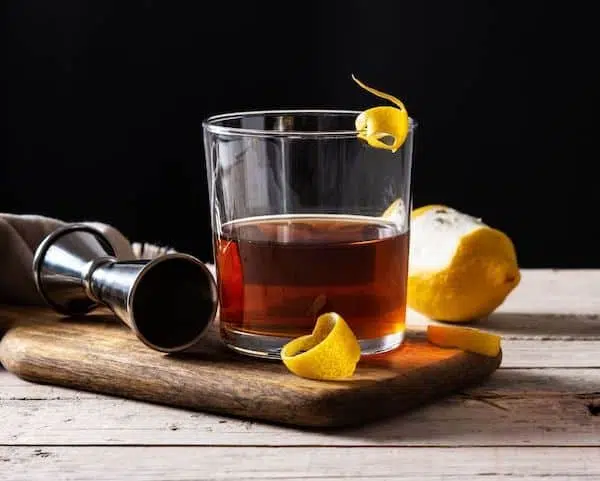
Angostura bitters are even a few years older. Dr. Johann Siegert invented them in 1824 as a medical tincture when he worked as surgeon general for Venezuelan military leader Simon Bolivar.
Just like Peychaud's, Angostura bitters is a family business. When the sons of Dr. Siegert joined the company, they created the iconic look of the Angostura bitters bottle.
Follow this link to read more on the history of Angostura bitters.
Besides their age and standing in the cocktail and bar industry, the two products are notably different. And both have very distinct flavor profiles.
Peychaud's bitters are less bitter with more pronounced sweet notes and a strong anise taste.
Angostura bitters, on the other hand, are full of spices like cassia, cloves, and cinnamon. That makes for a deeper flavor profile and a more savory taste.
Another difference between the two brands is the amount of alcohol. While Angostura contains around 44.7% ABV, Peychaud's bitters have a significantly lower amount of alcohol (35% ABV).
Both products are common ingredients in cocktails. Angostura is the most used bitters brand by far. Nevertheless, many classic cocktail recipes ask for Peychaud's bitters. .
Angostura produces the ultimate allrounder. Whenever a classic cocktail recipe asks for bitters, you can use their aromatic bitters without a second thought.
They are key to most of our favorite Sour Cocktails like the Pisco Sour or more exotic riffs like the Shochu Sour or the Pink Gin Sour.

Then there are classics like the Martinez, the Horse's Neck, or the Dark'n'Stromy, and also twists on classics like the Samurai Old Fashioned calling for a few drops of the flavor bomb from Angostura.
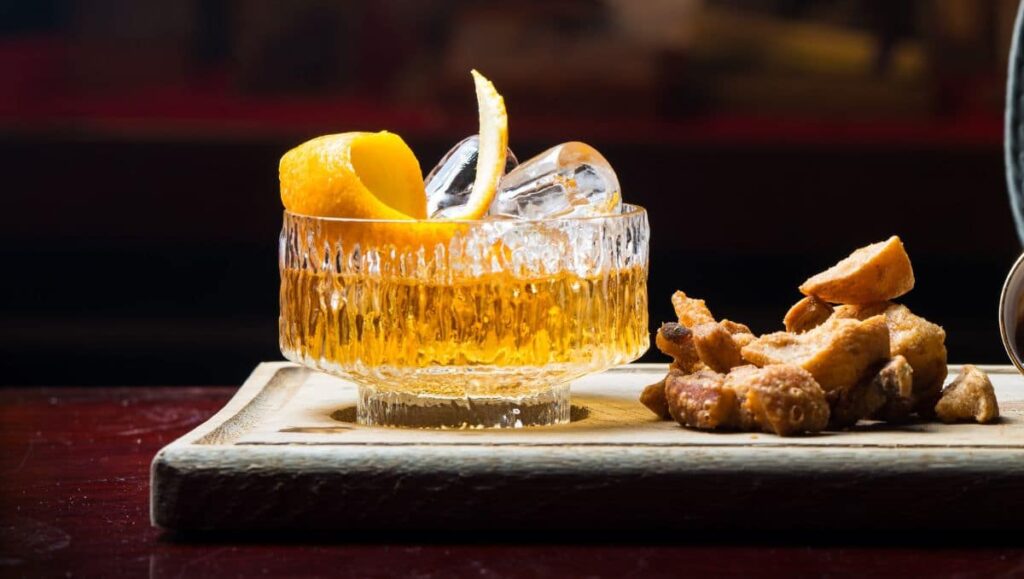
The most popular drink with Peychaud's is probably the already mentioned Sazerac. But it is also a key ingredient in recipes like Vieux Carré or the Queens Park Swizzle.
So even though they are not a perfect replacement for Angostura bitters, there are cases when Peychaud's bitters are the better option.
Their bitters are light and dry with strong notes of anise. It balances sweetness and acidity pretty well, making it a fantastic choice for drinks with many sweet or sour ingredients.
But to be honest, there is a reason why Angostura bitters are more popular. And it is not because one is ultimately "better" than the other.
Like I said previously, Angostura works with almost every flavor combination. They add complexity, and usually, you don't have to worry if it works. Just put some Angostura bitters to your cocktail, and they improve your drink nicely.
With Peychaud's bitters, you have to be more careful. They don't work all the time, and there is more trial and error involved in finding the perfect amount of Peychaud's bitters.
The most popular cocktail bitters are very dissimilar in taste. And they're also used in very different recipes.
Saying this, it makes sense to have them both at home. And it also makes sense to get familiar with what they actually do with your drinks.
Ultimately, Angostura bitters and Peychaud's bitters can lift your cocktails to the next level.
Classic cocktail recipes are fantastic and they allow making amazing riffs that can elevate the traditional formula with unconventional things. The Dill Pickle Martini is a prime example of that and a beautiful creation.
Pickles in a cocktail? Admittedly, this sounds a little unorthodox, but this Dill Pickle Martini is a real treat.
Quick Facts Dill Pickle Martini
It's a simple and refreshingly different version of a Dry Martini. Even non-Martini people will likely enjoy this drink. And with only three ingredients, this cocktail is also really easy to make.

The list of ingredients is short and sweet. You only need gin, pickle juice, and vermouth. As with every craft cocktail, each element has to be of good quality. There's simply no way to hide the inferior quality of products in such drinks.
If you want to make a variation, you can also opt for a Vodka-based Martini. The measurements remain the same. Also, the results are comparable, but we find the gin version is slightly better. Try them both, and see which one is your favorite.
You will be able to taste a subtle vinegar note of the pickle brine while the flavor profile drink still has the makings of a proper Martini. And a truly excellent one, as well.
If you like it spicy, you can choose a spicy pickle and replace the standard pickle juice with it. That adds some interesting piquant notes that also work tremendously well.
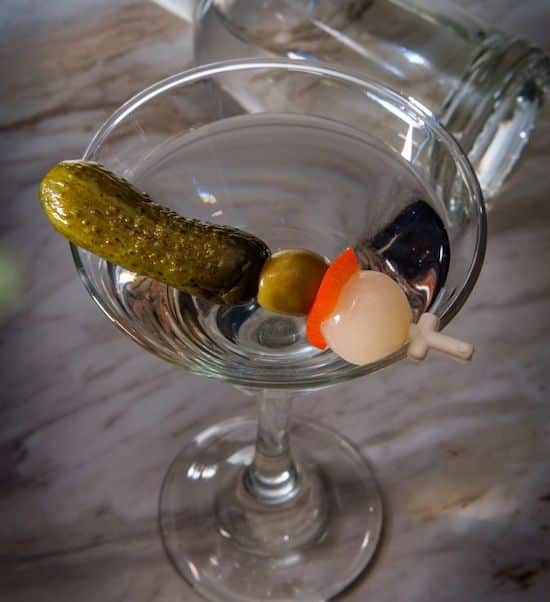
A Martini cocktail often comes with a garnish skewered on a cocktail pick. While a regular Martini is garnished with olives, you can stick with the pickle theme here.
So a pickle speared on a cocktail pick will top off this cocktail just perfectly. The dill pickle garnish adds a snappy aroma to the drink. It lifts the entire cocktail and makes it even more fun. -Not only for your tastebuds but also for your nose.
The trick to getting an exceptional Pickle Martini is the right balance between pickle juice and the other two ingredients. You don't want an overpowering vinegary taste in your cocktail. On the other hand, you definitely want to taste the pickle juice. It's a Dill Pickle Martini, after all.
To get the perfect result, use equal proportions of pickle juice and dry vermouth. That balances the flavors very well. Additionally, stick to these best practices:
You are a fan of a good riff on a Martini? Then try one of these crowd favorites:
Gin & Tonic has been a trending Highball cocktail for the past couple of years, and it is also a perfect cocktail for summer days.
And as the popularity of Gin and Gin & Tonic grew, the selection of glasses got bigger and bigger, as well.
People often ask me what the best glass for a Gin and Tonic is. And, in fact, I do have a preference. But there are multiple options that all work great.
I'll cover the pros and cons of each type. And there is also a glass you should get for a new experience of tasting Gin and Tonics.
The short answer is, yes, it makes a difference. The choice of your Gin and Tonic glass defines how you drink it.
The size of the opening has an impact on how you can smell the ingredients and botanicals. And a glass with a larger volume gives you more space for ice and botanicals.

There are four different kinds of glasses to serve a Gin & Tonic. The Highball glass, Long drink glass, Rocks glass, and the Copa.
Plus, there's also a special glass I want to show you. Let's start with the best Gin and Tonic glasses.
Since Gin Tonic is a classic highball drink, the highball glass is a natural choice. And it is indeed a great fit for a classic G&T.
The slim and tall shape is still a popular choice in many bars around the globe to serve a Gin and Tonic.

Yet, the Highball glass offers a relatively small volume. Especially when you add ice, the drink size gets pretty small.
Nonetheless, it has its benefits. If you can't stop yourself from constantly keeping your hand on it, the shape ensures your drink will be cold and fresh until you finish your drink.
Garnishing and botanicals are possible with this glass but are usually puristic. A slice of lime, lemon, or cucumber - that's it.
The shape of a long drink glass is similar to a Highball glass. However, it is generally larger.
It has a wider opening, is taller, and gives a lot more space and volume. Therefore, adding garnishes and botanicals to your G&T is much easier with along drink glass than with a highball glass.
Thanks to the wider opening, you can also smell the aromas of the botanicals more intensely.
A few years ago, heavy crystal long drink glasses trended and had been the number one favorite glass for a Gin and Tonic.
I also have them in my collection of cocktail glasses to serve Gin Tonics. They're robust, elegant, and have a decent size.
This one is currently my favorite G&T glass. The Copa, or Copa de Balon in Spanish, is a more modern Gin and Tonic glass. It first popped up in Spain, but you can find it everywhere now.
The Copa glass offers much volume and space, which allows you to add lots of ice and botanicals. That also allows the creation of extravagant garnishes for a top-notch visual effect.
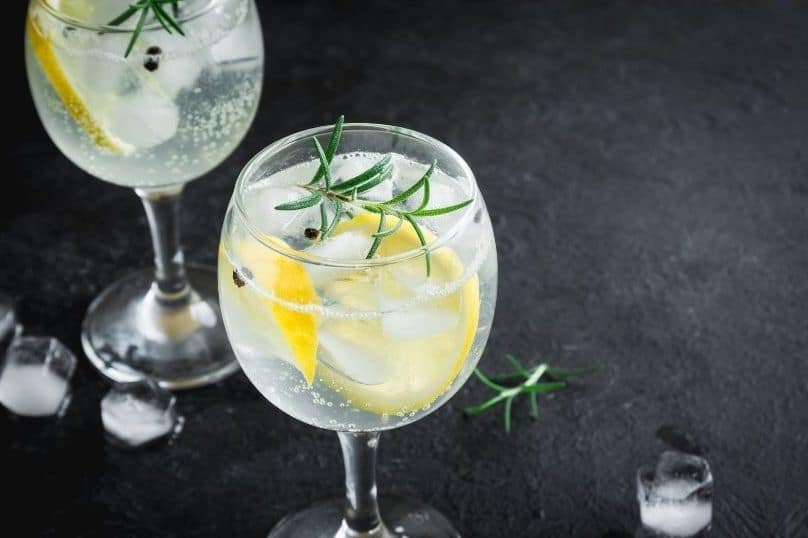
With its large opening and distinct shape, you can smell the Gin Tonic and the botanicals with every sip. So while enjoying the refreshing taste of your drink, you can also savor its vibrant fragrance.
And that's not all. The large ice cubes you can put into the glass will keep your drink chilled for a long time. Because you usually hold the glass at its stem, you're not warming up your Gin & Tonic glass while sipping.
The Old Fashioned or Rocks glass is another good option for a G&T. Some people swear on rocks glasses and never go with anything else.
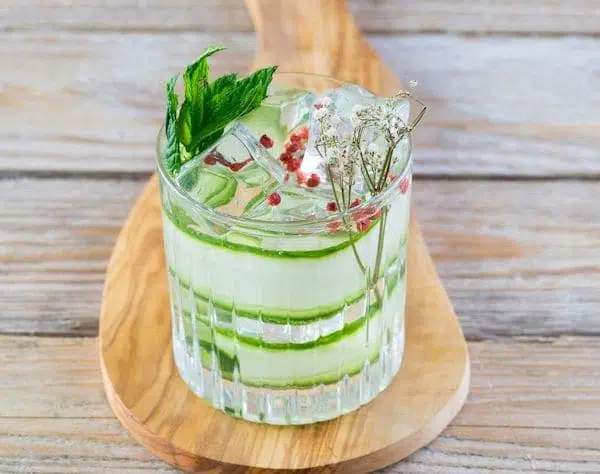
That sometimes feels a bit strange to me, though. Don't get me wrong. A rock glass is perfectly alright to serve a Gin Tonic. But the low volume combined with a wide opening makes for a completely different experience.
Of course, your G&T won't taste bad. But still, I find a Copa or Longdrink glass preferable.
The glass factory Eisch has created a tailored Gin and Tonic tasting glass. It's designed to be the perfect vessel to taste the spirit neat. But it also works when drinking a Gin and Tonic.
The mouthblown lower part is a small Copa shape. This bowl offers room so the Gin can unfold its aroma.
Then the chimney gets a bit wider from bottom to top. That way, you can smell the different flavors and aromas perfectly.
The trick here is adding tonic water gradually after having tasted your Gin of choice neatly. The wider opening lets you add a couple of ice cubes before pouring the mixer.
The glass is designed to create a different taste with every sip you take. Like that, you have a new balance between spirit and Tonic until you reach the perfect proportions. It's a clever approach to a Gin and Tonic glass.
The Gin and Tonic tasting glass is brilliant for tastings. But for serving some amazing Gin and Tonics, I recommend getting Copa glasses and/or long drink glasses.
Both work perfectly with a Gin and Tonic, and both are versatile. So you can use them for many other drinks, as well.
As I said already, for me, the Copa is the best Gin and Tonic glass. It's elegant, can carry lots of ice, offers room for garnish and botanicals, and it simply screams Summertime G&T.
I will show you the Copa glass I have in my home bar below. Also, if you prefer another style, I listed my recommendations for these.

That is my favorite and most used glass for serving Gin and Tonics. It is a brand from Germany that produces top-quality glassware.
Schott also patented the Tritan Glass material. That makes glassware shinier and easier to clean.
Even though their Copa glasses are super thin and huge, you can conveniently put them into your dishwasher without a worry.
The glass is big and has an extra-wide opening that lets you smell the beautiful fragrance while you sip your ice-cold Gin and Tonic.
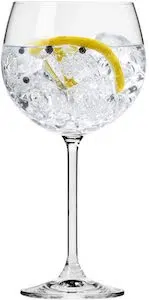
A smaller Copa glass that is also very elegant. It is easier to handle but offers less space to add ice and garnishes.
It's a good choice for everyone who prefers a smaller beverage size but still wants to serve their G&T in a Copa glass.
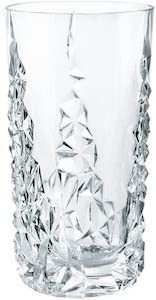
The Nachtmann Long Drink glasses are excellent. They are of high-quality, heavy crystal glass and made to last a lifetime.
You can get them in many different styles, not only in the Sculpture design. If you don't like the distinctive design, check out the classy Nachtmann Noblesse line.
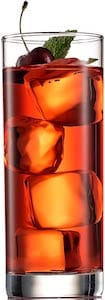
The Highball glasses from Paksh are as classic as it gets. Clean and elegant without any bells and whistles.
So, if you don't have some tasteful Highball glasses, they are a great option. They're also great value for money.

I'm not a massive fan of using a Rocks glass to serve Gin and Tonic. But perhaps you are. And in that case, these rocks glasses by Riedel are quite something.
The Riedel Rocks - or Old Fashioned- glass offer the highest quality and great design. They feel right as soon as you get your hands on them.
And if you should be in the mood for a Negroni, these are a sensational fit for that, too.
Dragon fruit grows on a specific type of cactus. And while the white-fleshed ones are readily available in many parts of the world, we want the pink variety for our dragon fruit syrup, which usually is a bit harder to get.
-Even in South-East Asia, where they're widely grown, the pink version is usually more expensive than the regular white ones. So, if you cannot get fresh ones, use frozen fruits instead.
Read here how to make a delicious dragon fruit simple syrup. This syrup has a beautiful, vibrant pink color and is perfect for riffs on classic cocktails. Used in a Gin Sour or a Gin Gimlet, the pink syrup is a great way to bring color into your drinks.
Perhaps you know it under the name Pitaya, Pitahaya, or dragon fruit, but they all refer to the same thing: an exotic, tropical fruit with pink or yellow skin.
Its English name - dragonfruit- derives from the Vietnamese word: Thang loy, which literally translates to dragon fruit.
The fruit is relatively large and has a hard and thick skin that protects the slightly sweet but otherwise surprisingly neutral fruit flesh. That makes dragon fruit syrup a brilliant replacement for simple syrup, as the taste is so similar. -Much like Butterfly pea syrup.
The most common variant of the fruit is not pink but white. And that's not all the color variation the fruit has to offer.
The skin can be either yellow or pink - each with green scale-like leaves. However, only the pink-skinned ones have different-colored fruit flesh.
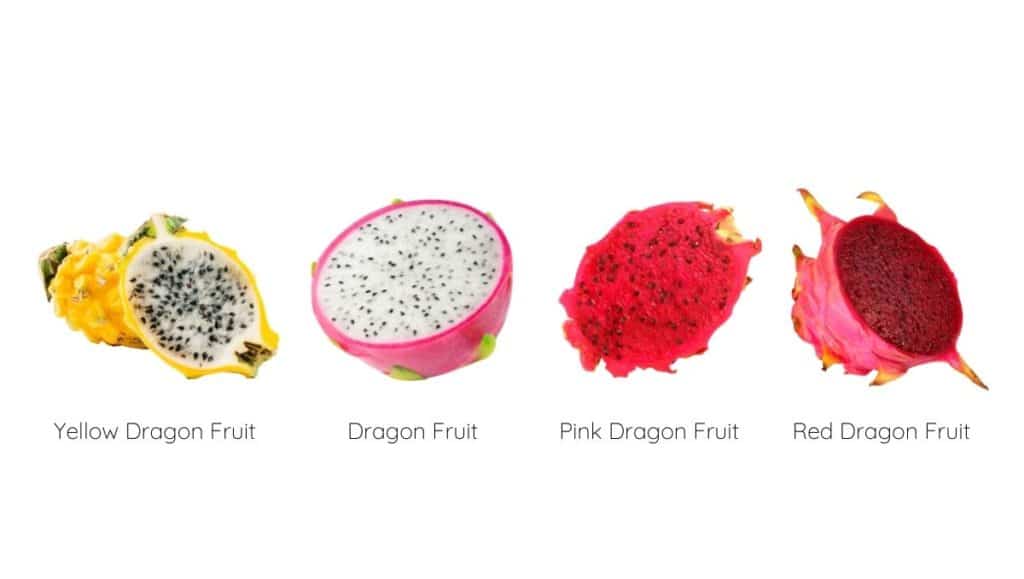
The most common dragon fruit variety is pink and green on the outside and white with black seeds on the inside. However, it is almost impossible for an untrained eye to guess the color of the fruit flesh by its outer appearance. So watch out for the labels.
For this dragon fruit simple syrup, white-fleshed dragonfruit can also be used but that is not ideal. That's not only because it clearly doesn't deliver on the color but also because it has an even less intense taste.
By the way, in Central America, you can even get dragon fruits with a dark red flesh color. But, so far, I have never seen them for sale anywhere else in the world.
The taste of dragon fruit is generally very mild. You can best describe it as a flavor-wise tuned-down mix between a kiwi, a watermelon, and a pear.
Its slightly sweet taste makes it a beautiful ingredient for desserts. Yet, the flavor gets lost in syrup and can turn out almost neutral. -Especially for the fruits with white flesh.
Pink dragon fruits are usually a little sweeter, more fragrant, and more flavorful than the regular white-fleshed version.
Apart from the different tastes, Pink dragon fruits also contain more antioxidants, having a positive effect on our eyes and skin.
So, now that you know everything about the Pitaya, it is time to try out our beautiful pink dragon fruit syrup recipe.
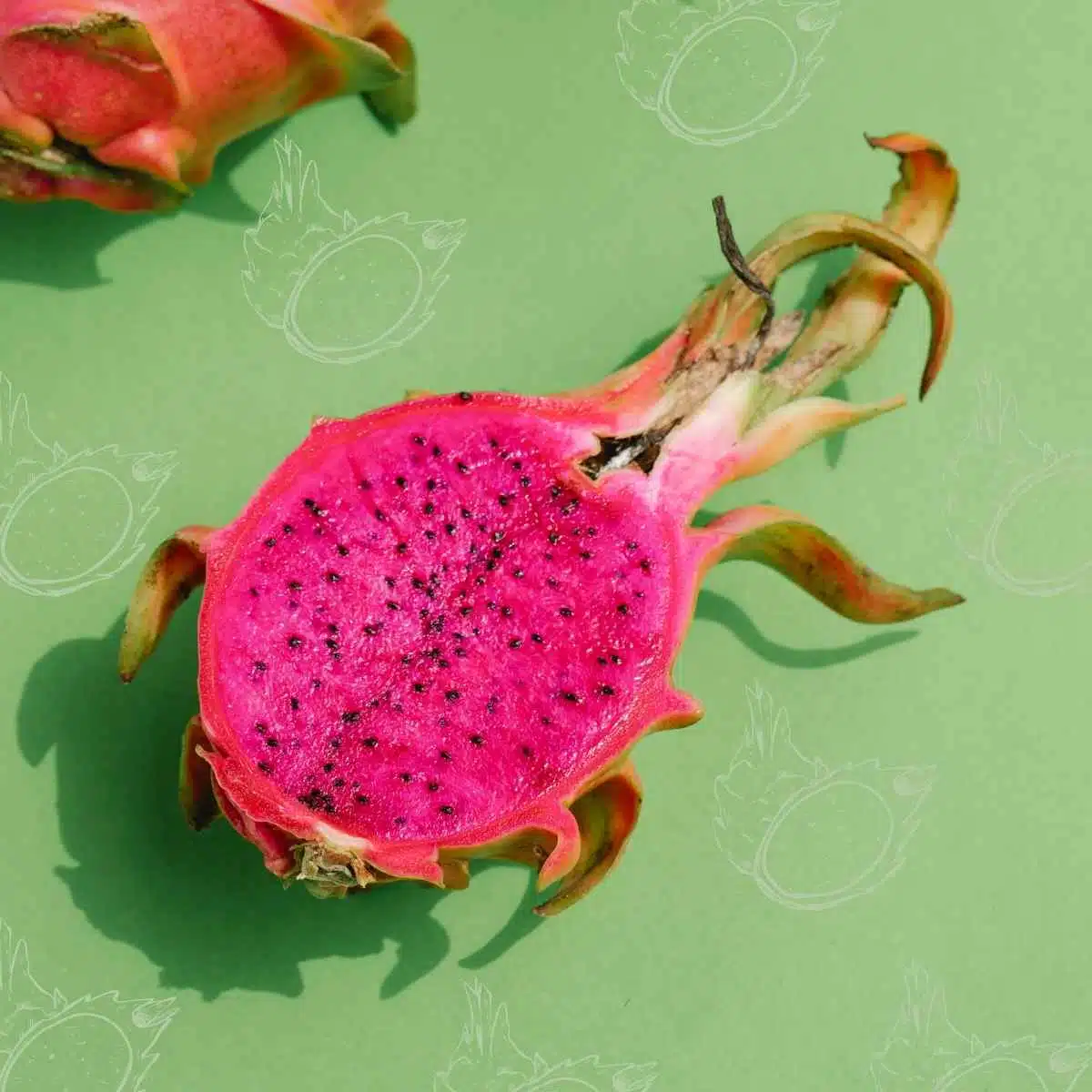
Learning to make cocktails at home can be complicated. So, a cocktail app might come in handy. Despite living in a time where accessing information is easier than ever before, it's still challenging to master a new craft.
Making cocktails or mixology is just that, a craft. It's about learning different recipes and new techniques constantly. You have to educate yourself about bar tools, history, and flavors that work together.
And honestly, learning all this at once is impossible. But luckily, some tools can assist with this: Besides the obvious platforms like YouTube and Instagram, there are also smartphone apps that really help you on this journey.
To help you pick the right app, I composed a list of the eight best smartphone apps for making cocktails at home.
If you're unsure about the right equipment, check out this post about the different types of cocktail shakers. There you can find all the tools you need to make delicious cocktails at home.

Cocktail Flow is one of the best cocktail apps for beginners. It not only offers a comprehensive design and User interface, but it also includes a large selection of cocktail recipes.
You can easily follow their step-by-step guides and won't get lost while shaking up your drink.
The app includes plenty of inspiration for your next drink. You can use text-based search to select a base spirit or browse collections of different recipes to find one that floats your boat.
It is also possible to make notes on drinks you already mixed. Perhaps you slightly altered the recipe, you thought it was perfect, or maybe you didn't like it after all. Then this ensures you won't make that drink a second time and better try something new.
One feature I am a big fan of is the My Bar tab. It lets you enter ingredients you have at home, and the app will then suggest cocktail recipes based on your home bar ingredients list.
Overall, a fantastic app for aspiring home bartenders. And it's free for Android and iOS.

BarSpoon is another app that's great for learning new cocktail recipes. It offers a sleek design and contains more than 400 recipes. You can download it for free on the iOS App Store.
What I like most about BarSpoon are the recipe cards. It's nicely designed with the option to switch from oz to ml measurements if required. You see which ingredients you need, which glass to use, and how to garnish your drink.
I also like the option to filter cocktails by age. You can select different Eras like "Turn of the Century" (1880 to 1919) or "Prohibition"(1920 - 1933) and get a list of cocktails from that time. This way you don't only learn new recipes but also a bit of history.

Modern Classics is a compilation of not-so-usual cocktail recipes meticulously curated by New York Times Journalist Robert Simonson. A great bartender app that will inspire you with unusual creations.
You will find recipes for barrel-aged cocktails, the Paper Plane cocktail, and so on. Robert Simonson evaluates each drink and explains why it made it into the app.
There's also carefully researched background information. And in my opinion, some of the cocktail recipes have the potential to be classics of the future.
This app is not as beginner-friendly as others but is a brilliant choice for aspiring home bartenders who want to learn more about modern-day mixology.
The app comes at a somewhat hefty price tag of $9.99. But for this, you get information you won't find in any other app. Unfortunately, it's only available for iOS, so Android users don't have the chance to check it out at this stage.

Mixel is a relatively new bartending app that is available for iOS and Android. It offers a wide selection of more than 1,900 cocktail recipes and many options to filter and sort them.
You even can add your own cocktail recipes to the Mixel database.
Like Cocktail Flow and Modern Classics, this app allows you to insert the ingredients you have at home. That makes it a lot easier to find recipes you can mix up straight away.
The download is free and gives access to 80 recipes. If you want full access, you have to pay for premium access. Currently, the premium upgrade is available for $11.99.

Have you ever been to one of the fancy bars that don't provide a menu? Where all staff members are well-trained bartenders that ask you for your preferences and mix up personalized cocktails?
With Bartender's Choice, you can almost get this experience at home now.
The app asks for your preferences regarding liquor, flavors, and styles of cocktails. Based on your answers, it recommends a list of suiting drinks. -Just like in a nice cocktail bar.
The knowledge behind the logic of this app comes from an actual and renowned bartender: Sam Ross created the app that's capable of serving perfect cocktails for everyone at home without having extensive knowledge of ingredients and recipes.
For only $4.99, you can get this for your iOS or Android phone, making you the bartender who mixes up custom cocktails for your friends and guests.

Highball is another quality home-mixologist app that is only available on iOS. This app features well-designed recipe cards organized in a stylish stack.
You can create and upload your own cocktail recipes. Simply add a list of ingredients with measurements and notes on How to Make the cocktail.
Those recipes are visible to all users of the app. They then can suggest twists and changes to your formula that might make it even better.
It's a beautiful app to keep track of your recipes and share and collaborate on them with other mixologists around the globe.

The Distiller app is significantly different from the smartphone apps above. One main feature is that it offers extensive knowledge about spirits on the market.
Have you ever been to the supermarket or liquor store and wondered which Bourbon Whiskey you should choose for your Continental Sour recipe? With Distiller, you can quickly look up the different options and check the reviews.
It's one of the best databases for spirits. You'll get a short description, reviews, tasting notes, and flavor profiles for almost every spirit brand on the market. -A great little tool to have on your smartphone.
Plus, you can also leave reviews and tasting notes, letting other users know your opinion on a specific spirit.
Best of all, the app comes completely free of charge. You only need to set up an account and can start browsing through its contents straightaway. I say it's an absolute must-have for your phone.

Ginventory is similar to Distiller. However, as the name suggests, this one is all about Gin.
As an aspiring home bartender, you might sometimes face the problem of finding the correct tonic water for your Gin to create a perfect serve.
That can either be solved by personal, encyclopedia-like knowledge about Gin or by simply asking Ginventory.
You'll find almost every Gin on this app, and it makes recommendations for tonic water and suitable botanicals. But that is not everything. The app also offers a review mechanism, making it a great tool to find new and high-quality Gins to try.
Absinthe is a sweet, anise, and licorice-flavored over-proof spirit invented in Switzerland. On average, a bottle of the green-colored spirit contains between 53% and 75% of alcohol by volume. It can be made from a variety of ingredients yet the most common ones are green anise, Grande Wormwood, and Florence fennel.
Absinthe has a mysterious air surrounding it. Many countries banned it for decades, and it got blamed for van Gogh cutting off his ear. The latter is wrong, as van Gogh suffered from depression and cut off his ear after a confrontation with Paul Gauguin. No Absinthe involved.
Absinthe is an over-proof (more than 50% ABV), green-colored spirit made from various herbs. Depending on the brand, you will find an extensive range of ingredients. The most common are green anise, Grande Wormwood, and Florence Fennel.
The roots of Absinthe are in Switzerland. That is why most of the herbs used for making it are from either Switzerland or France. It traditionally has an intense anise, almost licorice-like, taste. This green liquor was invented in the late 1700s by Pierre Ordinaire and quickly won the love of enthusiastic drinkers in France in the early 19th century.
Yes, today, Absinthe is legal in most countries. However, that was not always the case. Shortly after the beginning of World War I, many countries began to ban the the spirit, only to lift it again in 1988 (Europe), respectively 2007 (Unites States). But let's take a closer look at the historical timeline.
The very roots of the spirit are in ancient Egypt. Back then, people used it for medical purposes. But, as mentioned before, the spirit, as we know it today, was invented in the late 1700s in Switzerland. It quickly got famous in France, reaching its peak in popularity in the 1800s.
During the Belle Époque from 1871 to 1880, it was the favorite drink of many prominent figures. For instance, world-renowned artists like Vincent van Gogh, Oscar Wilde, and Ernest Hemingway, to name a few.
During this time, Absinthe was available and served almost everywhere. From cozy little Cafés to Bistros and Cabarets.
Then, in the early 1900s, it suddenly got banned in almost every country. The governments did that because of Thujone. Back then, people thought it would cause hallucinations and other unwanted side effects.
It all started in the US in 1912. France followed suit shortly after world war I began, and most other countries did the same. Spain and the Czech Republic continued production and consumption. That might be the main reason why, today, the Czech are leaders in Absinthe consumption.
The ban in Europe was lifted with the European Union's standards of 1988. In 2007, the United States legalized the high-proof spirit almost 20 years after the EU.
Absinthe can be used in cocktails, where its strong and distinct taste adds complexity to any drink. But traditionally, it is consumed either in combination with sugar and water (louche) in the Swiss preparation or by mixing it with burned sugar. The latter only works with Czech-style Absinthe.
Depending on the type you've got in front of you, there are different rituals to drink it properly.
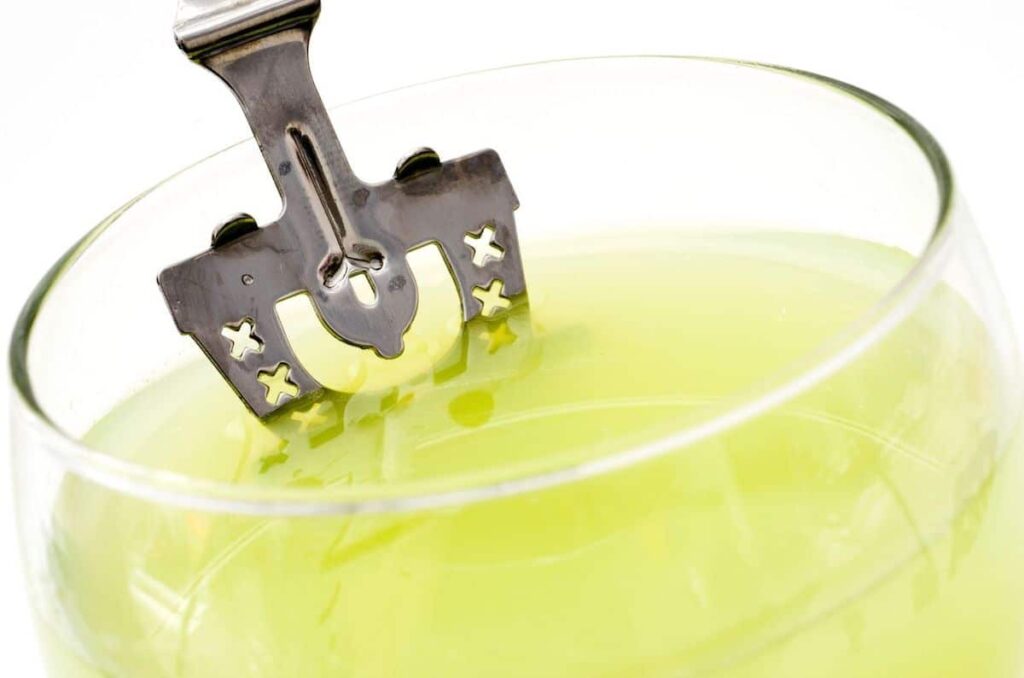
There are two traditional ways of preparing Absinthe - the Swiss and the Czech. So let's take at those two rituals:
The traditional ritual for Swiss-style products includes a serving of 1 to 2 ounces of Absinthe in a glass, an Absinthe spoon with a sugar cube on top, and a water fountain.
The water slowly drops on the sugar cube until it's completely dissolved. The water to Absinthe ratio is then around 3:1. The drink will also turn milky and cloudy during the process due to the anise in the spirit. This effect is also called louche and is best known in Ouzo.
So, here's the traditional Absinthe ritual:
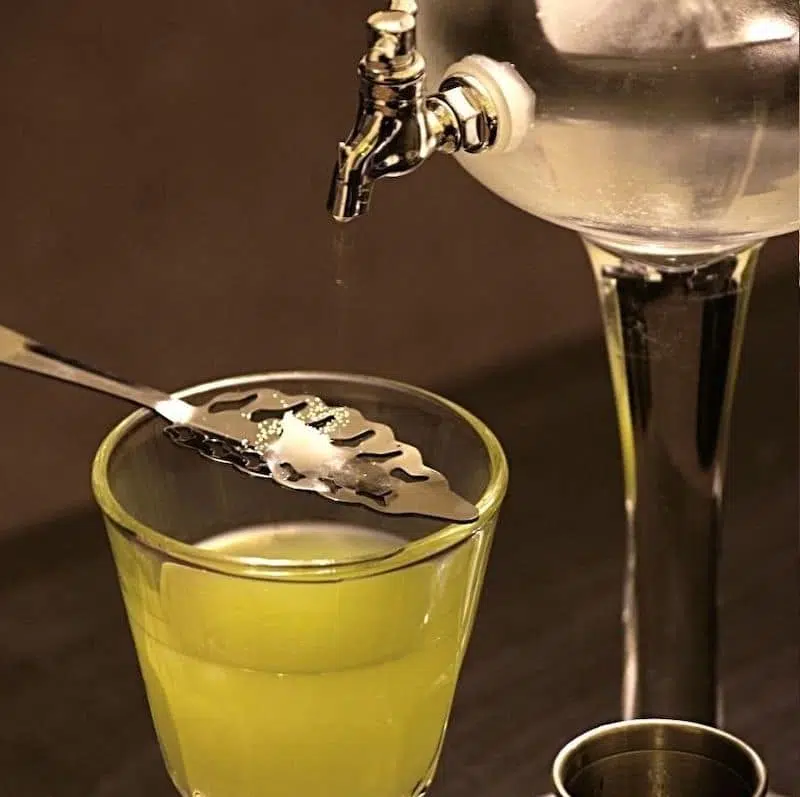
This is the second and more modern version to enjoy Absinthe. But it is only used for the macerated Bohemian version.
You dip a sugar cube into the spirit and place it on top of an Absinthe Spoon. Then you put the spoon on your glass filled with the spirit.
When igniting the soaked sugar cube, it begins caramelizing and slowly dripping into your glass. After 3 to 5 drops, dip the spoon into your glass and give the mix a good stir.
With this ritual, you get a warm drink with a very different flavor profile than the classic preparation.

If you want to know more about the rituals, read how to drink Absinthe properly. And always keep in mind that even if not toxic, it still contains a high alcohol level. Drink slowly, sip by sip, and always drink water in between.
The taste of Absinthe is strongly herbal with lots of sweetness. People often describe these sweet notes as licorice which is not part of it. However, the combination of anise and fennel is tastewise quite close to licorice, hence the mixup.
Ultimately, the taste of Absinthe depends on the brand you're drinking. But mostly, you will come across this licorice-like taste paired with a variety of herbal flavors.
Today, there are two types of Absinthe: the distilled and Bohemian version. Traditionally there was only the distilled version, but the Czech came up with their own style, which is prepared differently.
So let's take a closer look and see how exactly the two types of Absinthe differ.
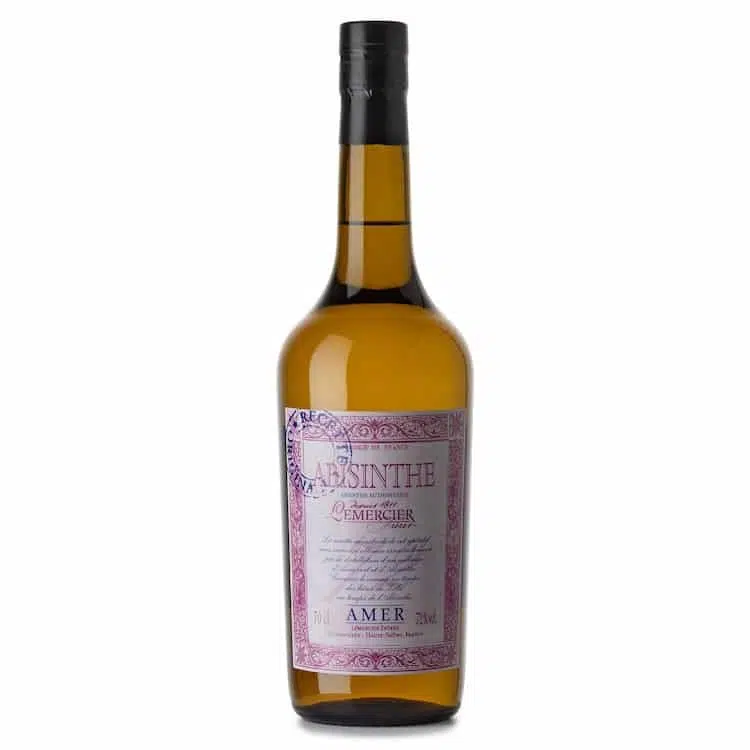
The classic type of Absinthe is distilled. The herbal ingredients get macerated before or during the distillation process.
Then, after distillation, the final product is ready to be bottled. Distilled Absinthes have herbal notes dominated by anise.
Right after distillation, the spirit is as clear as other spirits like Gin or Vodka. This clear version is also known as Swiss-style, Blanche, or Bleue.
To achieve the typical green color, distillers infuse their product with herbs in the second step of production before re-distilling it. The result is called French-style or Verte and, traditionally, cannot be colored artificially.
Quality Swiss or French-style Absinthe is also known for turning cloudy when mixed with water. This effect is called louche and is caused by the essential oils in anise that are not soluble in water.
Switzerland is, by the way, the only country that has defined legal requirements for Absinthe. And the general absence of laws led to a second, macerated version.

The new type of macerated Absinthes originated in the Czech Republic. For this, grande Wormwood is infused with alcohol to release aroma and the typical green color.
The green color is usually coming naturally through the wormwood infusion in alcohol. Artificial coloring is allowed.
While the end product is still full of herbal notes, it has a less dominant anise taste. If you're not a fan of anise, that's a big plus.
Also, the Bohemian-style Absinthe has no louche effect due to the lack of essential oils from anise.
These two characteristics, or rather their absence, are why bartenders often prefer using Czech Absinthe in mixed drinks.
Thujone is the main reason why Absinthe has a bad reputation. People accused the chemical compound of making consumers go mad and hallucinate. However, Thujone is neither a hallucinogen nor a psychedelic.
It is a chemical compound occurring naturally in Artemisia absinthium, better known as Grande Wormwood.
To be fair, Thujone is indeed toxic. But if you try to get intoxicated by it, you die of alcohol poisoning way before. Even sage contains more Thujone than Wormwood.
Ironically, despite all that, Absinthe legalization still depends on Thujone levels. In the US, only products with less than 10mg/L is legal. In the EU, you can purchase it with a Thujone level of up to 35mg/L.
By the way, the main reason for drinkers going bonkers was
Simply put, when someone was chasing the green fairy, they aimed for artistic enlightenment and inspiration. The term Green Fairy is a well-known synonym for the green spirit. There even is a brand of Absinthe going by the name "Green Fairy."
Initially, it was just the translation of the French nickname "La Fée Verte", but it quickly became more than that. In the late 1800s, the fairy was a common symbol in France for transformation and innovation. And a green fairy drink was said to create a free mind where new and unorthodox ideas could arise.
A state every artist strives for to get new inspiration. Of course, this does not necessarily have to include alcohol. But back in the day, it often did.
One of the best places to learn about Absinthe is the Absintherie in Prague. This place knows exactly what it's doing. They have one of the largest Absinthe selections in the world and serve both Czech and Swiss style from hundreds of brands.
I've been there multiple times. It's fun to sit in front of those massive water fountains waiting for your drink to be ready. You can try macerated as well as distilled ones while talking to the bartenders about their differences.
They will happily answer any questions you may have. And in case you're looking for more places to visit once you're in Prague, here's a list of the best cocktail bars in Prague.
Here's a list of the best Absinthe brands you should try. Our overview includes the style, origin, ABV, Thujone levels, and price.
| Absinthe | Style | ABV | Thujone | Price |
|---|---|---|---|---|
| Kübler Absinthe | Distilled | 53% | 5mg/l | $50 |
| Pernod absinthe | Distilled | 68% | 10mg/l | $60 |
| La Clandestine Absinthe Supérieure | Distilled | 53% | 10mg/l | $70 |
| Beetle Absinthe | Macerated | 70% | 35mg/l | $120 |
Sure, Absinthe is not the most common cocktail ingredient but it still is part of some classic cocktails like the Sazerac, Corpse Reviver No. 2, and Monkey Gland.
The boozy Sazerac cocktail was first created in New Orleans and required an Absinthe rinse during its preparation. The Corpse Reviver No. 2 is a little lighter than the Sazerac. Even if the name suggests otherwise. It contains just a dash of the high-proof spirit, but that's enough to bring in the spirit's distinct flavors. If you prefer something more fruity, try making a Monkey Gland cocktail.
For more cocktails with the Green Fairy, including one creation of Ernest Hemingway himself, check out our list of the 10 best Absinthe Cocktails.
Prague is one of my favorite places to go on a weekend trip. The city just has it all: A beautiful old town center, culture, some of the best beer, and also some of the world's best bars to have a cocktail, too. Honestly, I'm not exaggerating. There are some of the best bars in Prague I ever visited.
The bartenders love their spirits and are true masters of their craft, and they put so much passion and love into cocktail menus, drink preparation, and interior design.
There are a ton of bars I could recommend, but I limited myself to the top-of-the-line bars. Bars that make you want to go back over and over again. So get ready for my list of the best cocktail bars in Prague's old town.
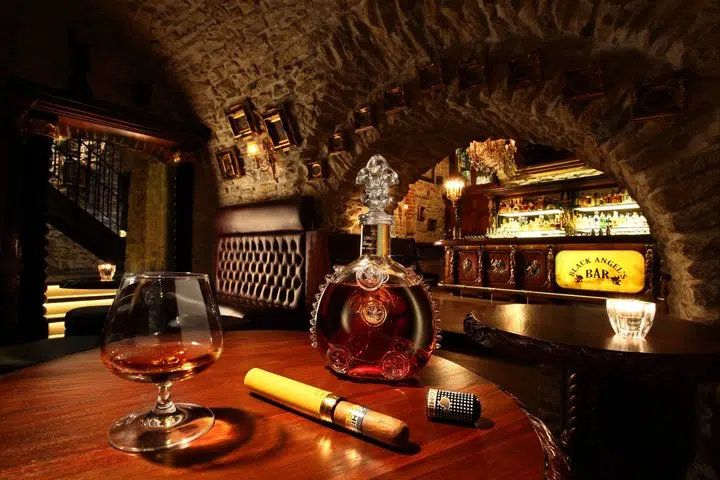
If someone asks me for cocktail bar recommendations in Prague, this is one of my first choices. Black Angel's Bar is epic.
Located in the lower levels of the 5 Star hotel U Prince, this bar is an absolute must-visit. It's right across from the Old Town Hall with its astronomic clock, one of the most touristic spots in the city.
But unlike some might think, this bar isn't a tourist trap at all. It is a true gem. It is a historic bar in a vaulted cellar with lots of bohemia crystal chandeliers, mirrors, and bartenders that are true legends.
To make the experience perfect, a pianist and sometimes also a saxophonist play in the background. The first time I walked into this bar almost ten years ago, I was blown away.
The bar, the service, the leather seats, the stone walls, and the vaulted ceiling - everything about the place is unique. Also, cocktail menu is also one of the best I've seen. Even though it slightly changed over the years, my favorite cocktails are still on the list.
It's a vibrant and diverse mix, from cocktail classics to tiki drinks. Many of the cocktails also have kind of a Czech twist on them. For instance, they experiment with Becherovka or Czech Whiskey.
A thing that is good to know when visiting the first time is that the bar has some special cocktails. It used to be five different cocktails put at the very beginning of the menu. All come with an additional feature which I don't want to spoiler here.
If you want to order my favorite cocktail, it is the 'From Dusk Till Foam'. It's incredible - sweet and sour with an unusual foam on top. It feels like the taste changes with every sip you drink.
Location of the Black Angels Bar

Anonymous Bar is probably my favorite cocktail bar in the city of Prague. It's hidden in a quiet courtyard in the Old Town and offers some of the most creative cocktails you can find in the city.
But it's not only the cocktails that make me go back again and again. The interior design is fantastic, as well:
Antique seating options, curtains, and furniture are placed throughout the bar. Subdued light only allows limited visibility and creates an intriguing vibe.
Many cocktails on the menu are served and prepared artistically. Ordering a 'Hot Fawkes' will start a show for the whole crowd. Then some cocktails are hidden on the menu and can only be found if you know what to look for.
And no, I'm not giving away the secrets of the menu - mainly because it is more fun discovering them yourself, but also because the hidden gimmicks change over time.
The bar also offers themed cocktails only available when you're in the bar at the right time. An announcement then lets everyone know that there's a special menu for the next one or two hours.
Projected on the bar's walls, you can order those drinks during that time frame. Anonymous Bar is high-class cocktail culture paired with an exciting and fun experience.
It seems that the creativity of the Anonymous team has no limits. That also might be one of the reasons why they came up with another bar in Prague. This one also made it on my list and is next in line.
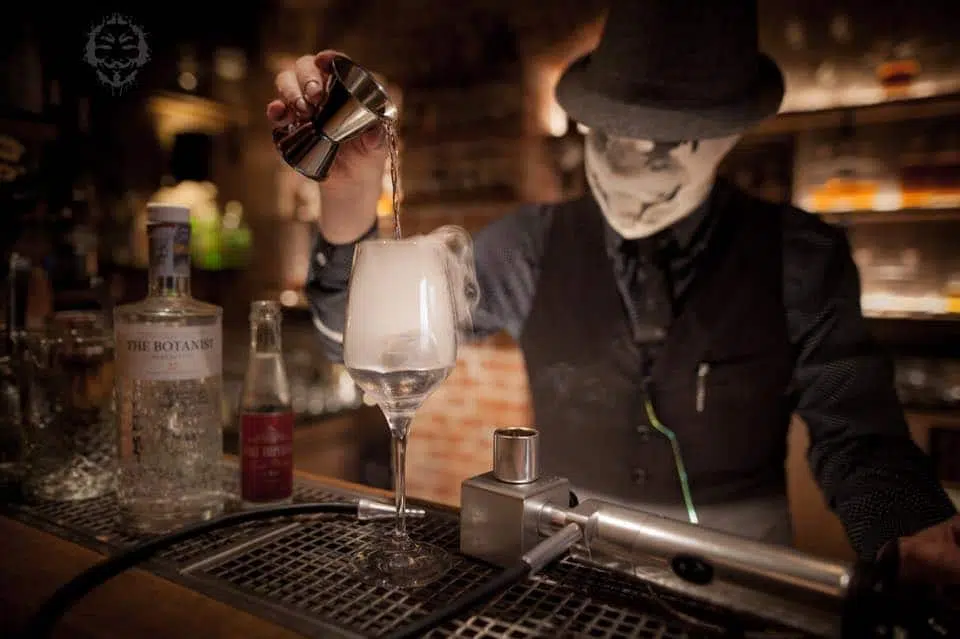
The second outlet of the guys behind Anonymous Bar is Shrinks Office. It's a hidden bar that you can only find if you know exactly where to look for it.
The entrance is hidden in a wall and can't be opened from the outside. Once the service staff let you in, they guide you downstairs to a small, cozy cocktail lounge.
It's best to make a reservation here as seating is extremely limited. -Making a reservation actually applies to every bar on this list but Shrinks Office only has space for a few small groups of people.
So be prepared and make a reservation upfront. The cocktails here are totally different from the Anonymous Bar but are equally creative.
As you might have guessed, Shrinks Office was inspired by Rorschach Comics.
The menu consists of Rorschach cards that show inkblots in various colors. There's no price tag and no text. You simply choose your drink by the looks of the blots.
I've never seen anything like this before. It's so much fun if you go there in a group and everyone is surprised by what they get.
If you have any food intolerance, don't worry, they check for allergies and ingredients you don't like. So a visit is absolutely risk-free.
That also applies to the price, which the menu doesn't state. But the cocktail prices are affordable, and you won't be shocked by the bill at the end of your evening.
The opposite even might be the case. On my first visit, I was surprised by how small the bill was. - Especially when one considers the quality and perfection this place offers.
And if this whole experience isn't extraordinary enough, there's even more. Every spirit they use in the bar is custom-made and can't be bought in a store.
They purchase quality spirits and tweak them by infusing, mixing, aging, and every possibility you can imagine. -A truly unique way to create cocktails.
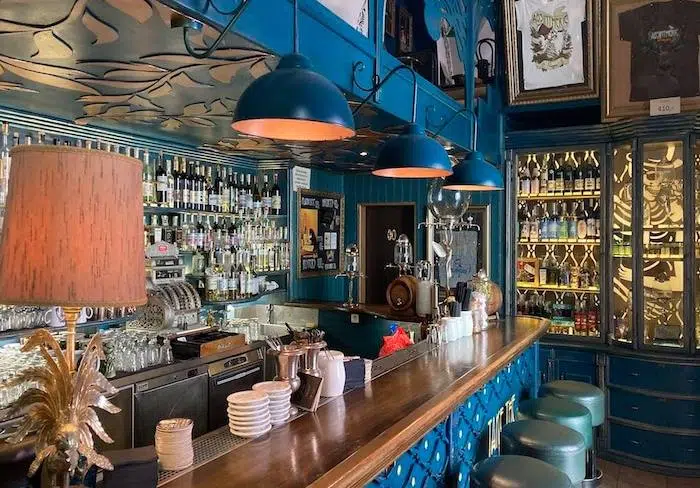
Absinthe is a highly alcoholic anise-flavored spirit. Historical literature often refers to it as la fée verte - the green fairy. Also, there are many famous Absinthe drinkers like Ernest Hemingway and Vincent van Gogh.
It was said to cause hallucinations and delirium, and some people claim that this is visible in one of van Gogh's famous paintings, Starry Night.
But let's talk about the Absintherie. It offers seating areas on two levels and has the most extensive list of Absinthe I've seen so far. If you never have had Absinthe, this is the place to try it.
Not only do they offer a tremendous selection to choose from, but they also have the expertise to prepare Absinthe the right way.
In the Ansintherie, you get the chance to experience the different ways to prepare Absinthe, depending on the type of Absinthe. There are two options, distilled and macerated Absinthes, and the bar offers both.
Trust me, the whole experience at this place is worth the visit. -A unique bar with an unusual offering you can't find anywhere else.
Location of Absintherie, Jilska
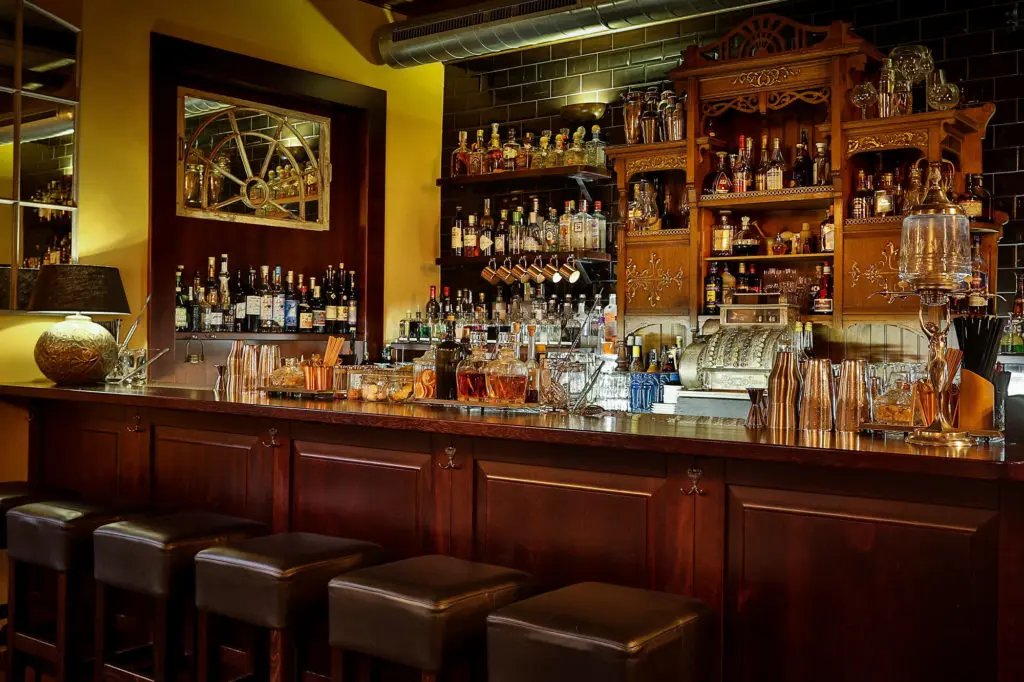
Hemingway Bar is one of Prague's most famous cocktail bars. This beautifully designed cocktail bar pays tribute to writer Ernest Hemingway, famous for his love of spirits and cocktails.
The whole bar is equipped with wood furnishings and fine leather seats. And that the interior is Cuban-inspired can't be denied. And of course, there are plenty of Photos of Mr. Ernest Hemingway all across the different lounge areas.
But the place is not only about interior design and theme. It serves delicious and very creative cocktails.
One drink you shouldn't miss is the Hemingway Daiquiri. A drink Mr. Hemingway himself invented during his time in Cuba.
And if you don't find something to your liking on the menu, let the barkeepers help you. As in all bars on this list, they know perfectly well how to whip up some custom cocktails that will wow you.
And even though the bar is quite spacious, it can be challenging to secure a set during busy times on the weekend. I had to wait in line many times already to secure a place in this beautiful cocktail bar. It is worth the wait, though.
If you feel like you need a drink right away and don't want to wait, you may stop by the next bar on this list. It's managed by the same guys as the Hemingway Bar and welcomes you in a little less busy setting.

The second outlet of the guys behind Hemingway Bar offers some beautiful drinks and food, too.
It's close to Hemingway Bar and a great alternative if you didn't get a seat over there. It's a super cozy place and very different from all the other bars on this list.
You can get excellent cocktails, but it's all a bit less fancy - less fancy doesn't mean less quality. They also offer some tasty Hot Dogs with homemade bread buns.
The other items on the menu also make for a great snack before heading to the next bar or club in Prague.
Update: I just learned that Cash Only had to close permanently. I still leave it on the list as I really liked the place, but unfortunately, you can't visit them any longer.

The last one on my list is Crazy Daisy. And the name doesn't lie. It is one crazy place that's not limited to Daisy cocktails.
The entrance doesn't look extremely promising, but once you're inside, you will be amazed. The whole place seems like a circus or amusement park:
Bartenders dressed as circus directors, animated walls, and a terrific, shiny bar area in the middle of the location.
Besides the animation and lights, purple and gold dominate the look of the bar. It feels a bit like entering a fairyland. And this doesn't stop with the interior.
The cocktails also are designed to the extreme. Cotton candy cocktails and spirit sorbets are nothing unusual to get here. -A truly amazing place to experience a very different type of cocktail bar.
Prague is not only great for having a beer or visiting the theater, ballet, or opera. Prague's Old Town is one of the best places in the world to get the highest quality cocktails in breathtaking cocktail bars.
I find that these bars can easily compete with bars in London, New York, Singapore, or Hong Kong. So the next time you're in Prague, plan some extra days and visit these cocktail bars.
If you find another remarkable place to visit in Prague, let me know in the comment section. I'm always happy about recommendations and will definitely check them out on my next visit.
Also, when traveling Europe, check out these places:
The key to making clear ice cubes at home is directional freezing. In simple terms, this means freezing ice slowly from top to bottom. This method prevents air and impurities from being trapped inside your ice cubes and will make your ice cubes crystal clear.
The best thing is that making clear ice cubes at home is not that hard. You only need a cooler, a freezer with enough space, and a bit of patience. Fill the cooler with water, put it in your freezer, and wait for 24 hours.
The basic idea of making clear ice is that by freezing from top to bottom the cubes do not capture air and impurities. Instead, you get crystal clear ice cubes you can add to your drinks. These impurities are pushed down the further the ice freezes until there is no more room. If you freeze the block completely, the lower bit will be cloudy.
Find a small-sized cooler that fits into your freezer. Fill it to 5 inches with regular tap water. Then place the cooler in your freezer without the lid. That helps freeze the ice from top to bottom, as only the top is exposed to the cold directly.
Let the ice freeze for approximately 24 hours. During this time the first few inches from the top will freeze to clear ice. The bottom will still be water which is excellent as this will contain all the impurities we do not want to have in our ice cubes.
After 24 hours, take the cooler out of the freezer and put it upside down in your sink or on a large and clean worktop. Most of the time, the ice block will slip down itself. If it doesn't come out, help by shaking until it comes out. The result is a crystal clear ice block ready to be cut into cocktail-sized cubes.
To cut the block of ice into portion-sized cubes, use a serrated knife and a towel for this procedure.
After you cut the ice into cubes, make sure to put them in a closed container and store them in the freezer. If you use them, let them sit at room temperature for about two minutes to prevent cracking when you put them in your drink.
The method of freezing ice in one direction from top to bottom is called directional freezing. It helps to create crystal-clear ice by not trapping impurities.
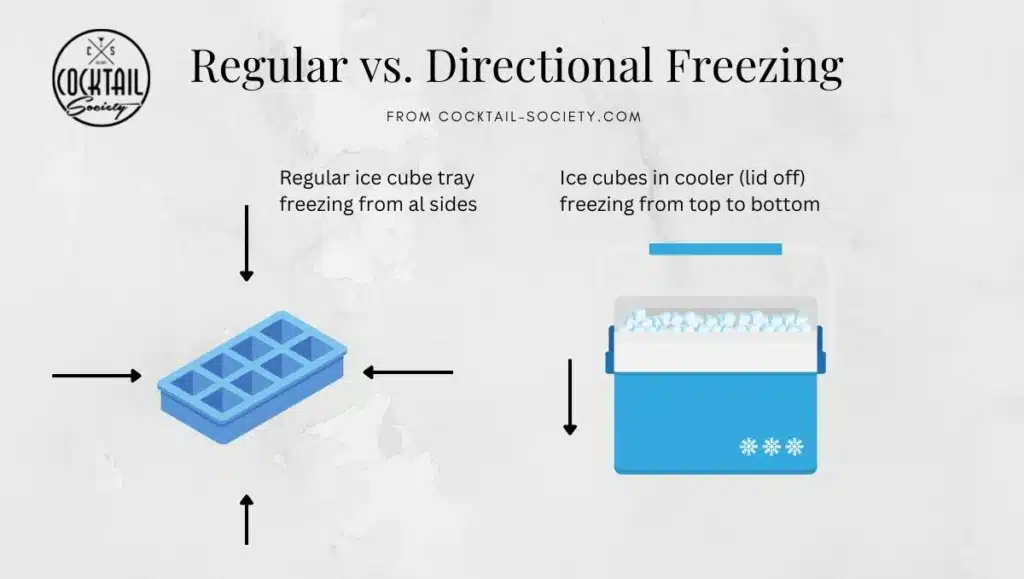
When water freezes, it pushes air, minerals, and other impurities away to freeze into a perfect crystal lattice. However, with regular ice cube trays, this happens on all sides simultaneously. That means the minerals, gases, and salts are transported into the center of ice cubes until there is no way out. The impurities are kept inside the ice and turn it cloudy.
Different qualities of ice melt at different rates. When using ice in cocktails, the choice of ice will directly influence the dilution of a drink. Using clear ice is not only visually striking, but this ice is also denser and will melt at a slower rate. That helps to chill your drink without watering it down too much.
The type of ice you should use in your drink can vary from spheres to cubes to ice sticks. While forming ice sticks from an ice block may be doable, crafting ice spheres require some time and practice. If you want to see how to carve ice spheres, look at the video below.
Below is a list of cocktails we lately created using clear ice. Click to see the images:
Cubes you freeze in ordinary ice cube molds would freeze from all directions simultaneously. As a result, the center is the last part that gets frozen and holds all impurities. That is why your ice cubes are cloudy and why it doesn't matter what kind of water you use.
Moreover, these bubbles not only make the ice cloudy. They also make the ice cubes melt much faster. That, in turn, also causes your beautiful Whiskey to turn into a watery mess within no time.
So, as a rule of thumb: the clearer the ice, the better the ice quality. Accordingly, clear ice will melt slower than a regular ice cube.
The good news is: yes, you can make clear ice at home. We tested different techniques, different water types, and ice molds. We used distilled water, tap water, and boiled water.
The water choice made for slightly different results, but using directional freezing is what will help you make clear ice cubes at home.
The best tools to use are:
The difference between the different water types exists. However, the results differ only slightly when using conventional ice cube molds. Distilled water and boiled water contain fewer impurities than tap water. But all varieties still have impurities that are trapped in the middle of the cubes during freezing.
The easiest and fastest way to get clear ice cubes for your homemade cocktails is by using a clear ice maker. You fill them up with any type of water, then store them in the freezer and pop out the perfectly clear ice once they are frozen.
These clear ice makers are not only easier to use but also smaller and fit almost any freezer compartment. A few products even offer different shapes. The only downside is that you will need to spend extra money and buy another tool.
Making clear ice cubes with one of these clear ice makers is a super easy process.
The short answer is no. Using boiled water will not make clear ice cubes if you use standard ice cube molds. What it does, is that the ice cubes are slightly less cloudy than if you make them with tap water.
When boiling water, oxygen, and other gases trapped in the water are dissolved. Thar reduces the number of impurities by a bit but will not remove them entirely.
However, when you combine boiling water with directional freezing, you get the best results.
Crystal clear ice cubes come in all forms, like regular cubes, spheres, shards, or diamond shapes. If you want to make perfectly clear ice at home, you need to understand that directional freezing is essential. Using boiled or distilled water won't help to make those cubes clear and see-through.
Considering this, you have two options: Use a small cooler to create an ice block and cut the cubes yourself, or use a clear ice maker to save yourself a lot of work.
When you think of Tiki cocktails, there's no way not to talk about the Mai Tai cocktail. It's one of the most famous Tiki drinks and a favorite of many.
However, despite this status, the Mai Tai had its issues in the past and still has some today. In an effort to be creative, the fruity rum cocktail often is made with cheap ingredients that ruin its initial objective, which was to highlight the rum.
Quick Facts Mai Tai Cocktail
So let's see how you can make an original Mai Tai that showcases the rum and be as fruity as it is delicious.
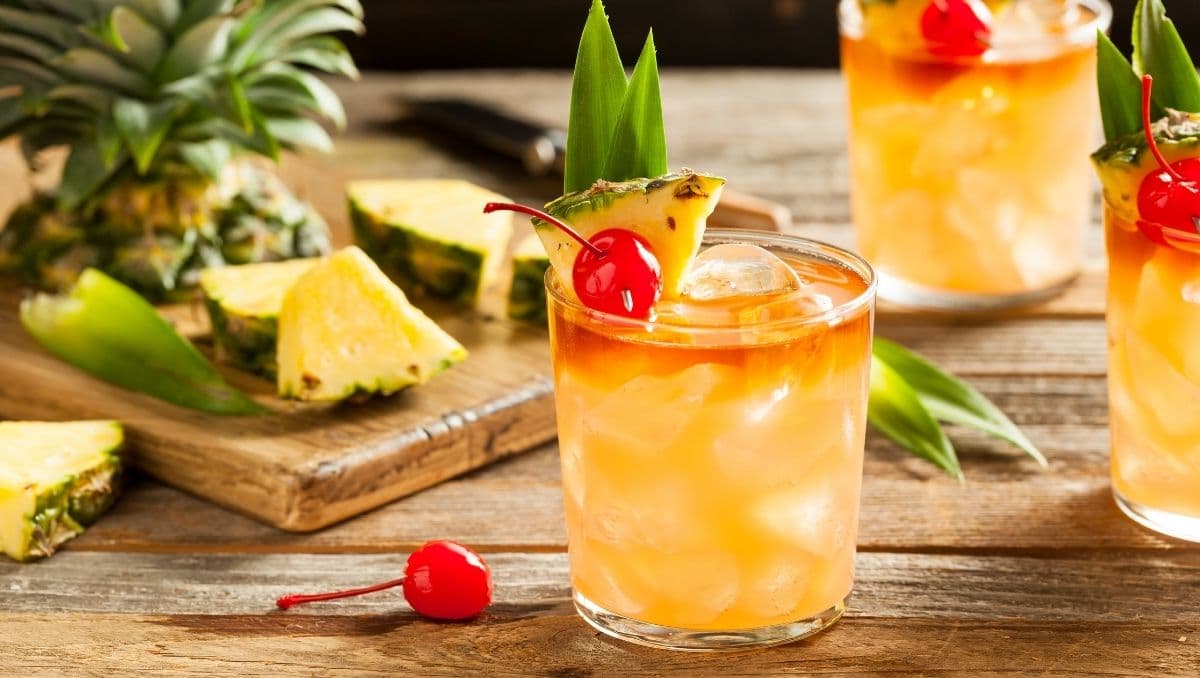
For the iconic Mai Tai recipe, you need the following:
A proper Mai Tai comes on crushed ice. You also shake it with crushed ice for a short time and then dirt-dumped (cocktail & ice) into your glass. So, you don't need a cocktail strainer for this legendary concoction.
For this, add all ingredients, except for dark rum, into your cocktail shaker with crushed ice and shake for 2-5 seconds only. When shaking with large cubes, you usually shake for about 15 seconds, but with crushed ice, this would leave you with a watery rum puddle.
Dirty-dumping means you pour the entire content of your shaker - with the ice - into a Double-Old Fashioned glass and then you add more crushed ice on top.
Only then should you float the dark rum on top to get the perfect Mai Tai with the lightly layered look.
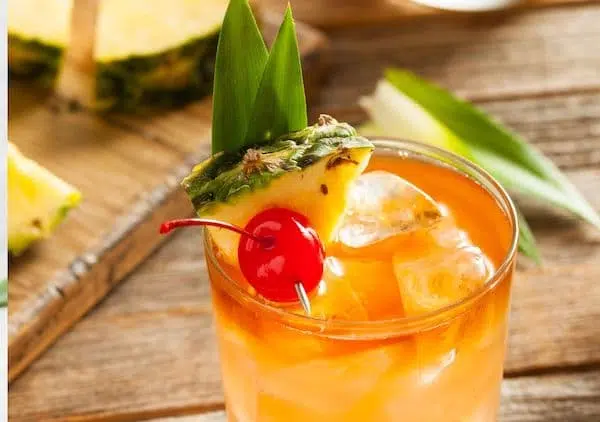
Mai Tai recipes are among the most tweaked cocktail recipes for many reasons. Number one is the search for the perfect rum base in the tropical cocktail.
The important part is that there is not only one feasible solution. You can create a beautiful Mai Tai cocktail in many ways. So, blended, non-blended, aged, or unaged light rum, all options have great-Mai Tai potential.
Orange Curacao is also an often substituted ingredient. Many recipes use a triple sec like Cointreau or another orange liqueur like Grand Marnier as a substitute.
To make the drink more tropical, bartenders often add more fruity ingredients like fresh orange juice or pineapple juice. I'm not a fan, but adding 1 ounce of pineapple juice to the recipe adds a sweet note and won't ruin your Mai Tai.
Jeff "Beachbum" Berry, a tiki cocktail legend also created a popular riff on the recipe called the Mai Tai Swizzle. This variation is from the 1950s and adds Falernum, grapefruit juice, and Pernod to the drink.
One of our favorite riffs is our Black 'N Bloody Mai Tai. A spooky Halloween version that's sure to impress your guests - visually and taste-wise.
The most told and one of the more credible stories about the origin of the Mai Tai is that the tropical drink is a creation of Tiki legend Victor Bergeron alias Trader Vic.
Allegedly, he invented the cocktail in the 1940s in his Bar Trader Vic in San Francisco. However, as with other famous drinks, many people claim the invention of the Mai Tai recipe for themselves.
-Now, even if the first appearance has been at Trader Vis's, Tiki legend Donn Beach probably created the base for this cocktail.
Donn Beach is another icon of Western Tiki culture and Trader Vic's biggest contender. Apparently, he once served a similar drink during the 1930s in his Beachcomber bar in Hollywood.
Together with the Zombie and the Grog, the classic Mai Tai is known today as the so-called Holy Trinity of Tiki.
Here's an excellent selection of Tiki cocktails to make at home:
If you're looking for an ice-cold and refreshing cocktail to beat the summer heat, we have the perfect cocktail for you - a Watermelon Mojito. Mojitos are a crowd favorite when it comes to summer cocktails.
Tangy lime juice, white rum, and fresh mint are a delicious combination. The watermelon makes this classic recipe fruity without taking away the crisp freshness.
One thing to keep in mind before you start mixing: If you use watermelon in a cocktail, make sure it's ripe. If your fruit is not mature enough, it will lack the required sweetness, and this causes the delicious watermelon taste to get lost in the mix.
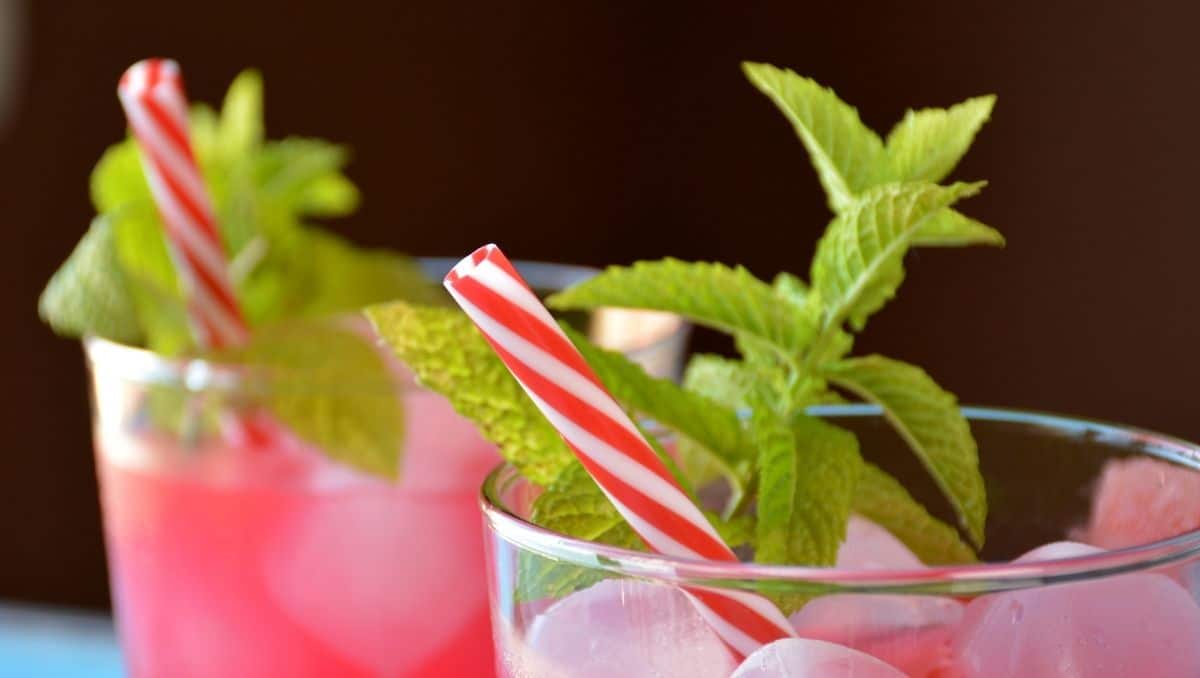
For our Watermelon Mojito, you need a blender, a bar spoon, and a jigger, plus a total of six ingredients, not counting the ice. Here are our recommendations for the perfect version of this drink:
Melon is a beautiful cocktail ingredient and can be used in various ways. Just think of the Midori Melon liqueur for the Midori Sour cocktail.
When you use fresh watermelon in cocktails, best process the watermelon before you mix the drink. The easiest way to do that is to cut the watermelon into pieces and chuck them in a blender. Then just blend it until it becomes a thick watermelon juice.
Don't freeze the watermelon, though, as the smoothie-like texture wouldn't mix very well. Because there's such a high amount of water in watermelon, it's too icy. And you want to be able to mix it thoroughly with muddled mint, lime juice, and sugar. Otherwise, the drink won't be as good as it could be. Then all you have to do is mix a Mojito with your watermelon.
Using fresh fruit comes with the trouble of potentially not being ripe. That is as valid for watermelon as it is for mango if you want to make a Mango Margarita on the rocks or for the fresh passion fruit you need for passion fruit syrup. And with fruit not native to where you live, it's always harder to tell if they are ripe or not.
Farmers found, for watermelon, you can follow these five easy tips:
A classic Mojito is mixed with cane sugar. That is an essential ingredient in this cocktail. But there are ways to reduce the number of calories and make it a Skinny Watermelon Mojito. The watermelon already plays a crucial part.
If the fruit is ripe, it will transfer this subtle watermelon sweetness into your cocktail. And that works as a substitute for most of the cane sugar from the original recipe. And, of course, if you prefer not-so-sweet drinks, you could make the whole recipe without sugar.
But for me, however, the drink needs a bit of sweetness. And if you're aiming for a low-sugar cocktail, I recommend adding just a pinch of sweetener. Our suggestion is to use stevia because it blends really well with the other elements in this recipe.